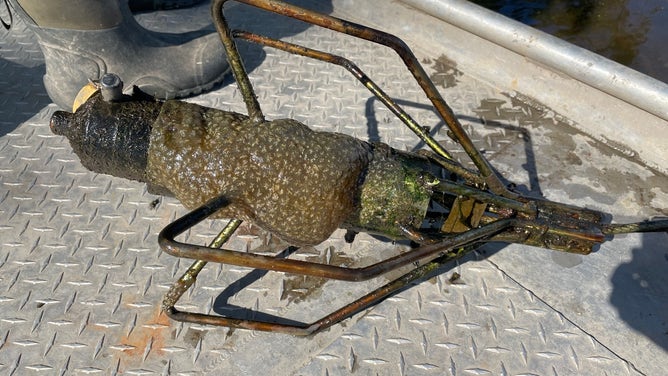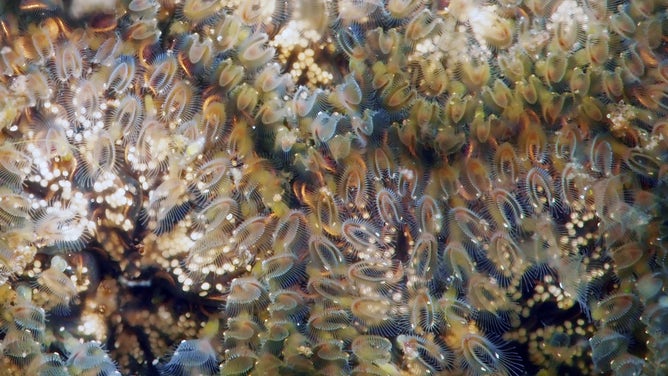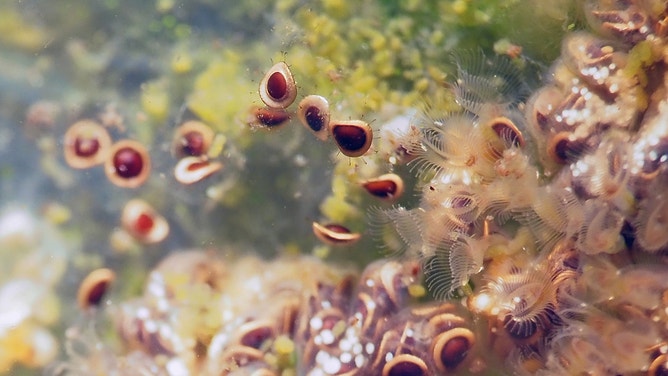Photos: Living 'blob of jelly' swallows equipment in unusual 'first'
The 'blob of jelly' found on the underwater equipment is actually a colony made of thousands of tiny animals called a Pectinatella magnifica, or Bryozoan colony.
Research team discovers world's largest coral in southwest Pacific
FILE VIDEO: A group of scientists working aboard a research vessel in the southwest Pacific Ocean has discovered the world’s largest coral. Thirty-four meters wide and thirty-two meters long, the gigantic organism is a complex network of coral polyps—tiny individual creatures—that have grown over a span of three centuries. (Video: National Geographic Pristine Seas)
A delicate blob with thousands of tiny animals made its new home on a U.S. Fish and Wildlife Service telemetry receiver – a "first," according to the U.S. Fish and Wildlife Service's Midwest Fisheries Center.
While it's not uncommon for other critters, including insects, snails, mussels and crayfish, to be found on the receivers, the Midwest Fisheries Center said the "blob of jelly" was different.
USFWS Biological Science Technician Katie Lieder said the bryozoan colony was found on a telemetry receiver in the Black River in La Crosse, Wisconsin.
The "blob of jelly" found on the underwater equipment is actually a colony made of thousands of tiny animals called a Pectinatella magnifica, or Bryozoan colony.
GOLDEN EAGLE KILLED IN FIRST RECORDED WIND TURBINE INCIDENT IN SCOTLAND

A brown, jelly-like bryozoan colony on an acoustic telemetry receiver.
(Katie Lieder/USFWS)
"After we downloaded fish tracking data from the receiver, we returned it and the attached bryozoans to the water, undisturbed. It did not interfere with our equipment at all," Lieder told FOX Weather.
Each animal in the Bryozoan colony is called a zooid and can feed itself with a horseshoe of tentacles. The photo below shows a closer look at the horseshoe-like tentacles on each animal in the blob.

A closeup look at a bryozoan colony reveals each animal's horseshoe-shaped rows of tentacles.
(Roger Tabor/USFWS)
According to U.S. Fish and Wildlife Services Visitor Service Manager Julia Pinnix, these colonies are made up of thousands of animals no larger than 5/32 of an inch wide. These tiny animals float alone and eventually form colonies.
Pinnix said the animal colonies are similar to coral in the way they work together to build structures. Each animal is called a zooid and can feed itself with a horseshoe of tentacles.
MANATEES MAY BE RECENT ARRIVALS TO FLORIDA, STUDY SUGGESTS
"But coral builds strong, sturdy structures that last long after the animals they house have died. Bryozoans also make structures from calcium carbonate, but far more fragile ones," Pinnix writes.
However, this group home won't stay together through the winter.

A closeup of a bryozoan colony releasing seed-like statoblasts.
"Bryozoan colonies die off in the winter when the water gets cold, so it is no longer living on the receiver," Lieder said. "Before they die, the colonies form statoblasts, which are like tiny buds with a protective shell. These float away and lie dormant over the winter."
The photo above shows the hard statoblast, which looks like seeds floating away.
When the water warms up, the statoblast will form new colonies next year.
